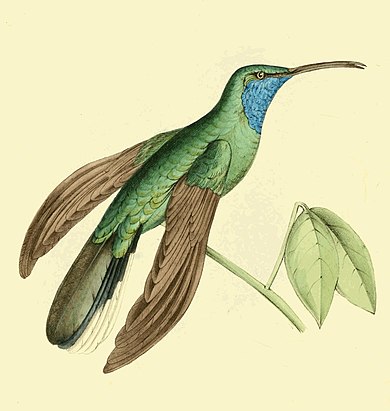Zoological Illustrations/VolII-Pl107

TROCHILUS ensipennis,
Blue Sickle-winged Humming Bird.
Generic Character.—See Pl. 82.
Specific Character.
- T. (div. curvirostræ) aureo-viridis, mento juguloque cæruleo-violaceis; rectricibus paribus; alis falcatis, remigum primorum scapis dilatato-compressis.
- Curved-bill Humming Bird, golden green; chin and fore part of the throat violet-blue; tail even; wings falcated, greater quills with the shafts dilated and compressed.
I have already offered some observations on the remarkable construction in the wings of T. falcatus, figured at pl. 83; and the bird now before us is another unrecorded species, possessing exactly the same formation. I was at first inclined to believe this bird was the male of the T. latipennis, (or l'Oiseau Mouche à larges tuyaux of Buffon), from the under plumage in that species being uniform grey, a common indication of the female Humming Birds; but a further comparison of the two has proved this supposition to be erroneous. They differ, not only in colour, but in their bills; in that of T. latipennis, the curvature is so slight, that it may be almost called straight; whereas in this, the curve is very apparent. I have little doubt future observations will show, that these singular quill-feathers, now known to exist in three species of this family, are peculiar only to the male birds.
This extremely rare bird is in my own collection, and is not improbably unique; the figure is strictly of the natural size; the plumage, above and below, is a uniform deep green, with a metallic reflection; half way down, the throat is dark violet blue; tail even, and very broad, the middle feathers obscure green, the next pair raven or bluish-black, and the others white, with a black base.
The progress which has been made towards ascertaining the geographic distribution of animals, leaves no doubt that this bird is an inhabitant of either the Continent or Islands of South America; but of what particular country is unknown.
